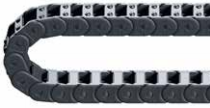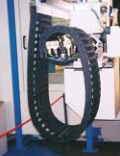Laying cables correctly for pivoting movements
mkogelmann | 26. March 2020
For pivoting and rotary movements of up to 270°, it is important that cables and hoses are laid in the energy chain’s neutral phase. Why is this so important?
Pivoting and rotary movements usually involve winding up the e-chain or guiding it into an S shape. For normal installation positions (horizontal, standing, or suspended), the energy supply always follows a semicircle, no matter what position it happens to be in.

For pivoting and rotary movements, the e-chain also starts in a semicircle. But the more it pivots or is wound up, the greater the additional pivoting or winding radius.


The e-chain remains snug to the specified winding radius. If the chain length is now measured directly from the inner radius and the outer radius, there will be a clear difference.
The cables in the energy supply interior behave similarly. Cables that have been laid towards the outer area must pass through a much longer distance than cables that are laid further inside. Relative movements arise among the individual cables and between cables and the e-chain.
To avoid such relative movements and the associated abrasion, cables should be laid in the e-chain’s neutral fibre – that is, on the continuous line of the pin/bore connection. Strain relief can then be applied to both sides of the energy chain.
